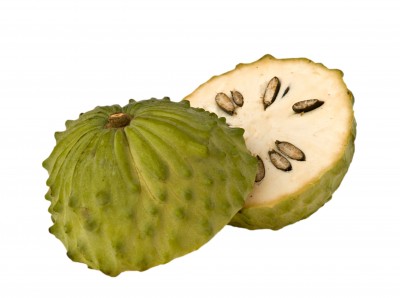Graviola - Soursop

Common Names: Graviola, Soursop, Guanabana, Guanavana, Brazilian Paw Paw, Brazilian Cherimoya, Guanábano (Spanish, international), Brazil papaya, Corossolier, Corossol Épineux (French), Nangka Blanda, Nangka Londa, Toge-Banreisi, Annona muricata, Annona cherimola, Sour Sop, Guanabana, Guanavana
Latin Name: Annona muricata
Origin: Africa, Asia, South America
Short Introduction
Graviola is grown primarily for its sweet-sour fruit. Annona muricata is the fastest-growing species of the Annonaceae family. Its fruits can weigh several kilograms and the tree may take more than five years to produce mature fruit. In non-tropical regions, it can only be cultivated in greenhouses where temperatures do not fall below 17°C (62.6°F). Before sowing, soak the seeds in water for two days and plant them in peat-based substrate, gently pressing them into individual pots. Keep the substrate slightly moist. Germination requires steady warmth (25–30°C/77–86°F) and may take up to six weeks. Successful cultivation demands experience and care.
Detailed Description
Graviola is a remarkable plant long used in natural medicine by indigenous tribes in South America.
Botanical Information
Graviola, known botanically as Annona muricata, is an evergreen tree reaching 5–6 meters in height, native to the tropical regions of South and Central America. It features large, oval, dark green leaves that do not shed. Its unique flowers are initially female and later become male. The tree produces yellow-green, edible fruits covered in soft spines. This fruit, commonly sold in local markets as 'guanabana' and sometimes called 'Brazilian Paw Paw,' has pulp frequently used to prepare beverages. The leaves, bark, and roots all have a longstanding role in traditional medicine.
Origin and Distribution
Graviola originates from tropical areas of South and Central America. It is also found in parts of Africa and Southeast Asia, growing best in humid, warm climates. Once a wild tree, it is now cultivated for both its fruit and other medicinal parts due to its established value in traditional healing practices.
Usage / Dosage
Graviola has been treasured by indigenous communities across South and Central America for centuries. It entered European medicine and laboratory research in the mid-20th century. Folk medicine recommends graviola for treating infections caused by bacteria and parasitic organisms, including leishmaniasis. Traditional healers frequently use infusions of graviola leaves or seeds for viral infections—there are accounts of its use in treating herpes and even HIV-related infections.
South American traditional medicine, particularly in Cuba, recommends graviola as a potent antioxidant and immune booster for colds and mild viral illnesses, as well as for asthma and immune response disorders. Research has supported its antiparasitic potential, noting sensitivity of certain parasites—such as those causing leishmaniasis—to annonacin and corossolone found in graviola.
Some sources—drawing on traditional knowledge—highlight its potential against certain types of cancer. Scientific studies (mainly animal-based) have explored how graviola's active compounds might halt the growth of cancer cells. Additional studies have examined a possible synergistic effect when graviola is used alongside established cancer treatments. Folk medicine celebrates graviola’s ability to kill cancer cells and inhibit tumor growth.
Graviola seeds (in larger quantities) have traditionally been used to induce vomiting and empty the intestines. Folk remedies also employ graviola for coughs and inflammatory conditions of the nose, throat, and pharynx. Many value graviola for promoting relaxation and restful sleep, and it is used to alleviate depression and anxiety. In older children, graviola has been used to reduce fever, ease muscle cramps, treat ulcers, and support digestion.
Flowers are used in folk medicine as an antispasmodic for abdominal colic and digestive pain. In the Caribbean, graviola is a popular remedy against fevers. Decoctions of graviola leaves are also recommended for inflammation and swollen limbs. Animal studies suggest a possible analgesic and anti-inflammatory effect.
Smaller clinical studies have tested graviola's compounds for their ability to help regulate high blood pressure and cholesterol levels. Research has also described mild reductions in elevated blood sugar among those taking graviola in appropriate doses. Externally, graviola is used for arthritic pain, fatigue, and rheumatism.
Active Compounds
Research has confirmed the presence of specific compounds called acetogenins—primarily annonacin acetogenins—that are thought to have cytotoxic effects on cancer cells. Intensive research is ongoing to extract and synthesize these substances as potential cancer therapies, though no successful medicines have yet been developed. Acetogenins are found exclusively in the Annonaceae (custard apple) family, and they have exhibited antimicrobial, antiparasitic, and antitumor properties.
Graviola’s phytochemical profile includes acetogenins, epoxy-acetogenins, various polyketide epoxy-derivatives, annexed acetogenins such as annonacin, corossolone, coronin, montekristin, annomuricin, bullatacin (potential anticancer effects), muricapentocin, muricoreacin, murihexocin C, reticulin, N-methylcoclaurine, lectin, compounds C and D cohimbine, isoquinolines (mild antidepressant effect), alkaloids, and derivatives such as bis-tetrahydrofuran and cis-monotetrahydrofuran. Labs are still trying to synthetically produce these compounds.
Traditional Dosage
Decoction: Add two tablespoons of dried material to 750 ml of cold water. Bring to a boil and simmer gently for 10–20 minutes. Strain and drink 250 ml three times daily.
Alcohol-free (AF) tincture dosage: Shake, then take 20 drops four times daily. Place drops in the mouth and allow to absorb through the mucous membranes; may be followed by a small amount of water. The recommended daily dose contains 1,776 mg of fresh plant material.
Capsule dosage: Take 3 capsules three times daily, 20 minutes before meals.
Powder dosage: Mix one teaspoon of graviola powder in water and drink, three times daily.
Warning: Graviola is not recommended for people with low blood pressure, as it may decrease it further. Consult a healthcare professional before use if you are taking medication for high blood pressure. Graviola should not be used during pregnancy, as it may promote uterine contractions.
